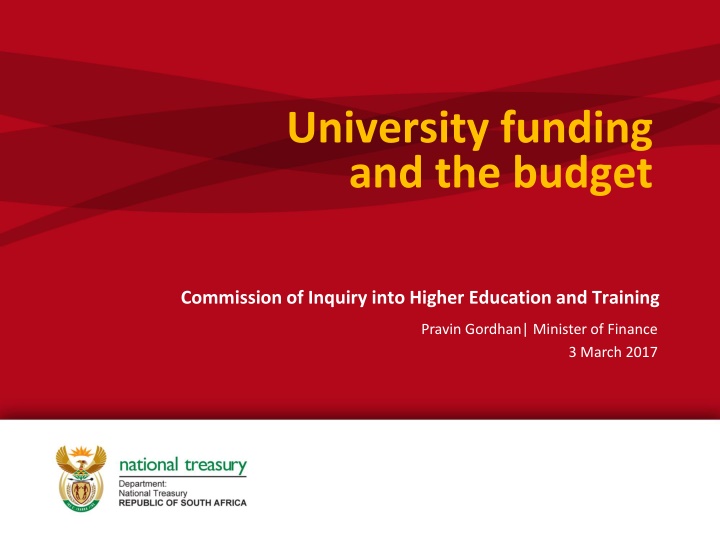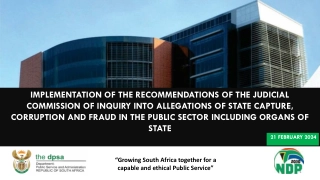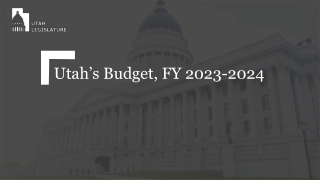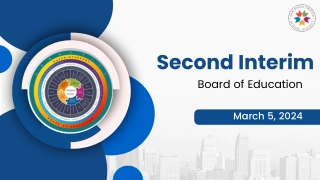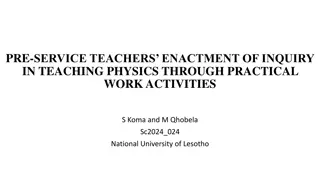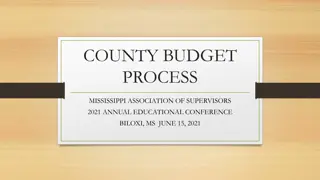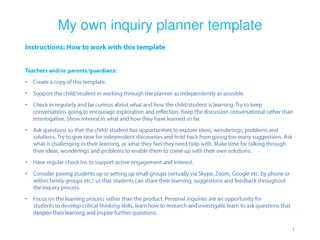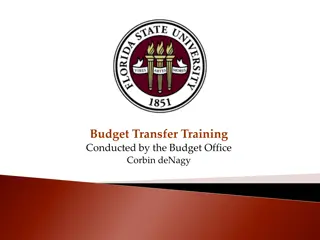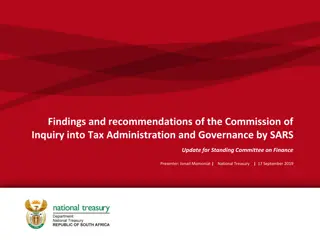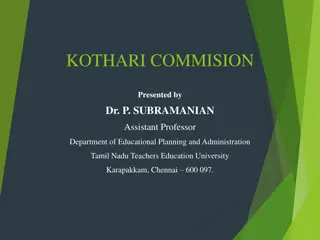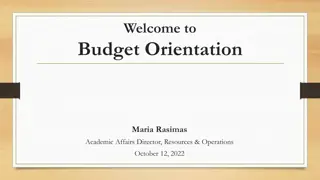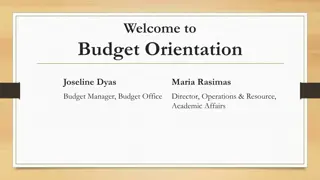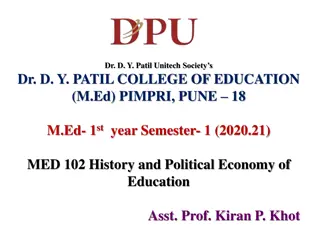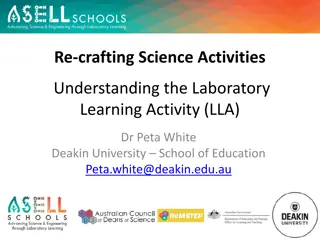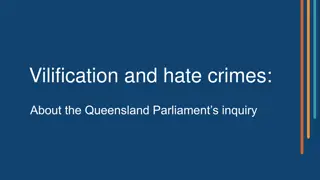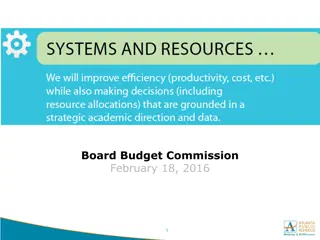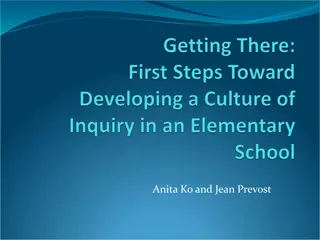Higher Education and Budget Commission of Inquiry
Minister Pravin Gordhan discusses the challenges facing higher education funding and budget management in South Africa. The discussion covers points of departure, South African realities, and the importance of transformation for inclusive growth, with a focus on the role of education in driving economic development and social change.
Download Presentation

Please find below an Image/Link to download the presentation.
The content on the website is provided AS IS for your information and personal use only. It may not be sold, licensed, or shared on other websites without obtaining consent from the author.If you encounter any issues during the download, it is possible that the publisher has removed the file from their server.
You are allowed to download the files provided on this website for personal or commercial use, subject to the condition that they are used lawfully. All files are the property of their respective owners.
The content on the website is provided AS IS for your information and personal use only. It may not be sold, licensed, or shared on other websites without obtaining consent from the author.
E N D
Presentation Transcript
University funding and the budget Commission of Inquiry into Higher Education and Training Pravin Gordhan| Minister of Finance 3 March 2017
Points of departure Higher education as part of the education value chain Inclusive growth Revenue Fiscal space Expenditure = Revenue + Borrowing Lower growth = lower deficit = lower borrowing + debt management The socio-economic reality of SA competing priorities Political priorities = MTSF = budget priorities Since Great Depression (2008/9) cutting expenditure + raising taxes But safeguarding social spend No austerity But, demands on budget greater than total spend ? New round of cuts might be necessary? Higher education and training roadmap through dialogue + diversity of solutions 2
South African realities Income growth has been uneven - the bottom 20 per cent have benefited from social grants and better access to services, the top 20 per cent have benefited from the rising demand for skills and pay increases. Those in the middle have been left behind. Wealth remains highly concentrated 95 per cent of wealth is in the hands of 10 per cent of the population. 35 per cent of the labour force are unemployed or have given up hope of finding work. Despite our progress in education, over half of all children in Grade 5 cannot yet read adequately in any language. More than half of all school-leavers each year enter the labour market without a senior certificate pass. 75 per cent of these will still be unemployed five years later. Our towns and cities remain divided and poverty is concentrated in townships and rural areas. Our growth has been too slow just 1 per cent a year in real per capita terms over the past 25 years, well below that of countries such as Brazil, Turkey, Indonesia, India or China. 3
Transformation for inclusive growth To realise the vision of the Constitution, South Africa needs transformation that opens a path to inclusive economic growth and development. Growth without transformation would only reinforce the inequitable patterns of wealth inherited from the past. Transformation without economic growth would be narrow and unsustainable. Broad-based transformation should promote growth, mobilise investment, create jobs and empower citizens. It must create new resources to support social change, including assets and livelihoods for the majority, and strengthen South Africa s constitutional foundations. The budget plays a central role in transformation by promoting redistribution and directing scarce resources towards catalytic investments in human and physical capital. The 2017 Budget proposes several difficult trade-offs to safeguard citizens quality of life, improve the efficiency of spending and ensure that the public finances are sustainable. 4
Education is key to transformation The quality of our schools and further education institutions is at the heart of our commitment to our children s future. A clear plan needs to consider the impact of different education interventions to maximise social and economic transformation. Decisions and trade-offs are required to ensure balanced, sustainable development that meets the vast needs of the population using available resources. Improvements have to begin in the foundation phase of the education value-chain . We will continue to increase resources for early childhood development, improve our basic education outcomes and step up our support to TVET colleges and universities. Government recognises the needs articulated by students in universities and TVET colleges. As the economy grows, we will be able to do more to finance an expansion in tertiary education opportunities and improvements in student funding. Civil society initiatives involving business, churches and other organisations have created space for a diversity of options to be considered. The President has invited stakeholders to participate in processes that are underway so that all views are heard. 5
Together we can find a roadmap for higher education Given the magnitude of student funding requirements, it is imperative that we develop a clear roadmap towards a better higher education and training system. It must clearly indicate how society will achieve access, opportunity, financing and support for students in the university and further education sectors. Several broad principles will assist in finding the way forward: Government is determined to address the challenges identified in post-school education and training in a phased manner. Resources will be taken into account in determining the pace with which these can be addressed. Government stands ready to engage with education stakeholders and adapt financing arrangements as may be required in future years, within the scope of available resources. Universities, students and education stakeholders share responsibility for improving access and quality and the diversity of higher education and training provided, within a framework of consultation rather than confrontation. A growing contribution is needed from employers and industry through funding of bursaries, internship opportunities and research programmes, recognising that this is the foundation of future productivity and technology advances Together, we will find a way forward that meets student funding needs fairly and sustainably, so that rising numbers of graduates can contribute positively to inclusive growth and transformation of the economy. 6
Stronger and more inclusive growth is required The projected rate of economic growth is insufficient to reduce unemployment, inequality and poverty. The budget is highly redistributive, but stronger economic growth is needed to sustain the fiscal position. Moving to a path of stronger and more inclusive growth requires: Transforming patterns of asset ownership and production, promoting competition and de-concentrating product markets. Mobilising private and public capital investment in tandem to help modernise and diversify the economy. Providing workers and the poor with access to markets, and social and economic infrastructure. Strengthening transparent government and the rule of law. Investing in research and development, and innovation. Improving the quality of education and training to meet the needs of a modern economy. 7
National Treasury Presentations to the Commission 1st briefing: 12 August 2016 2nd briefing: 7 October 2016 Fiscal policy and macroeconomic context Constitutional and policy background to resource allocation in the national budget Choices and constraints in Budget 2016 The bill of rights Taxation: principles and medium term policy considerations Government policy documents Budget process Issues in budgeting for higher education Budget decisions making in context: needs vs available resources Education budgets Budgets for post-school education and training University sources of income Further considerations in the allocation of resources to universities 8
The basic budget equation Expenditure = Revenue + Borrowing EXPENDITURE BORROWING REVENUE > > > Inputs, outputs and impacts Economic growth and revenue collection Growth and Sustainability > > > Effective allocations Tax rates and economic growth Growth and interest rates > Efficiency > > Tax policy and tax administration Credibility > Ability to pay vs. willingness to pay > Taxpayer compliance, tax morality and the Laffer curve 9
Tax revenue shortfall in 2016/17 Gross tax revenue for 2016/17 is R30.4 billion lower than the original estimate at the time of 2016 Budget. There is uncertainty regarding the path of revenue collection. Risks include weaker- than-expected economic growth, and concerns about tax morality, compliance and administration. Revenue performance against budget targets (2016/17) 10 6.8 5 R billions 0.7 0 -1.0 -1.5 -2.3 -5 -6.5 -10 -11.3 -15 -15.2 -20 PIT Customs Specific Fuel levy Other DWT CIT VAT excise 10
Tax proposals The tax proposals this year will raise an additional R28 billion. A new top personal income tax rate of 45 per cent for those with taxable incomes above R1.5 million. An increase in the dividend withholding tax rate from 15 per cent to 20 per cent. Limited bracket creep relief, increasing the tax free threshold from R75 000 to R75 750. An increase of 30c/litre in the general fuel levy and 9c/litre in the road accident fund levy. Revenue impact of tax proposals R million Taxes on individuals and companies Personal income tax Revenue from not fully adjusting for inflation Revenue if no adjustment is made Bracket creep adjustment New top marginal income tax bracket Dividend withholding tax Taxes on property Indirect taxes Increase in general fuel levy Increase in excise duties on tobacco products Increase in excise duties on alcoholic beverages Increases in the excise duties for alcohol and tobacco, of between 6 per cent and 10 per cent. 16 516 12 148 14 628 -2 480 4 369 6 822 -448 5 133 3 197 656 1 280 An increase in the transfer duty threshold from R750 000 to R900 00 will provide relief to the affordable housing market. 11
Consolidated fiscal framework Government is committed to a measured path of fiscal consolidation that contains the budget deficit and stabilises public debt. The combination of a lower expenditure ceiling and higher taxes will narrow the consolidated budget deficit from an estimated 3.4 per cent of GDP in 2016/17 to 2.6 per cent by 2019/20. Consolidated fiscal framework 2013/14 2014/15 2015/16 2016/17 2017/18 2018/19 2019/20 Outcome Revised estimate Medium-term estimates R billion/percentage of GDP Revenue 1 008.1 27.8% 1 098.9 28.4% 1 222.0 29.9% 1 297.3 29.4% 1 414.1 29.8% 1 535.2 29.9% 1 668.5 30.1% Expenditure 1 143.4 31.5% 1 233.5 31.9% 1 364.2 33.4% 1 445.2 32.8% 1 563.1 33.0% 1 677.1 32.7% 1 814.3 32.7% Non-interest expenditure 1 033.8 28.5% 1 112.1 28.8% 1 227.9 30.0% 1 291.8 29.3% 1 393.8 29.4% 1 489.5 29.0% 1 608.0 29.0% Interest payments 109.6 3.0% 121.4 3.1% 136.3 3.3% 153.4 3.5% 169.3 3.6% 187.6 3.7% 206.4 3.7% Budget balance -135.4 -3.7% -134.6 -3.5% -142.2 -3.5% -147.9 -3.4% -149.0 -3.1% -141.9 -2.8% -145.8 -2.6% Primary balance -25.8 -0.7% -13.2 -0.3% -5.9 -0.1% 5.5 20.3 0.4% 45.7 0.9% 60.6 1.1% 0.1% 12
Main budget primary deficit continues to narrow Despite revenue underperformance, the main budget primary deficit will halve from 1 per cent of GDP in 2015/16 to 0.5 per cent of GDP by the end of 2016/17. Main budget non-interest spending has stabilised at around 26 per cent of GDP Tax increases and buoyancy over the last five years have supported a substantial improvement in revenue Main budget revenue and non-interest spending 26 25 Per cent of GDP 24 23 22 21 Revenue 20 Non-interest spending 19 1996/97 1998/99 2000/01 2002/03 2004/05 2006/07 2008/09 2010/11 2012/13 2014/15 2016/17 2018/19 13
Net debt stabilising below 50 per cent of GDP Gross and net debt outlook 55 50 Per cent of GDP 45 40 35 30 Gross loan debt 25 Net loan debt 20 2018/19 2006/07 2008/09 2010/11 2012/13 2014/15 2016/17 2020/21 2022/23 2024/25 14
The trend rate of growth has fallen Average growth (2000 - 2008) 5.65.5 4.3% 5 5.3 4.6 4 4.2 Average growth (2010- 2019) 3.7 3.6 3.6 Per cent 2.0% 3 3.1 2.9 2.7 2 2.2 2.2 2.02.2 1.5 1 1.3 1.3 0.5 0 -1 -1.5 -2 2000 2001 2002 2003 2004 2005 2006 2007 2008 2009 2010 2011 2012 2013 2014 2015 2016 2017 2018 2019 Real GDP growth Source data: Reserve Bank and National Treasury 15
Consolidated spending in 2017/18 Agriculture, rural development and land reform R26.5bn 2% Post-school education and training R77.5bn 5% The national budget is strongly aligned with constitutional imperatives. Health R187.5bn 12% Basic education R243.0bn 16% About two-thirds of the 2017 Budget is allocated to functions dedicated to realising constitutionally mandated social rights including education, healthcare, social security and housing. Social protection R180.0bn 11% Debt service costs R162.4bn 10% Human settlements and municipal infrastructure R195.8bn 13% General public services R70.7bn 4% Defence, public order and safety R198.7bn 13% Economic affairs R215.0bn 14% 16
Debt-service costs and post-school education grow fastest Growth in consolidated government expenditure Nominal average annual growth over MTEF Debt-service costs 10.5 Post-school education and training 9.2 Health 8.3 Social protection 8.2 Human settlements and municipal infrastructure 8.0 Economic infrastructure and regulation 7.8 Basic education 7.3 Industrial development and trade 6.4 Science, technology and the environment 6.0 Defence, public order and safety 5.7 Employment, labour and social funds 5.3 Agriculture and rural development 4.7 General public services 2.8 0 2 4 6 8 10 Per cent 17
Funding post-school education: the fastest growing budget Government has significantly expanded funding of education over the past 20 years. Over the past five years, expenditure on post-school education and training has grown much faster than other budgets. Despite fiscal constraints, subsidies to universities grow at 10.9 per cent each year and transfers to NSFAS grow at 16.1 per cent over the medium term. Index of budget allocations in real terms Post-school education and training Health Social security and welfare Basic education Police Defence 140 130 Index (2011/12 = 100) 120 On average, non- interest expenditure grows at 7.1 per cent. 110 100 Medium-term expenditure framework estimates 90 2011/12 2012/13 2013/14 2014/15 2015/16 2016/17 2017/18 2018/19 2019/20 18
Funding post school education: a growing share of GDP Allocations have increased from 1 per cent of GDP in 2008 to 1.5 per cent today. But most of this increase benefited vocational colleges, SETAs and the National Skills Fund, rather than universities. Post-school education and training budget as a share of GDP Other Skills levy Technical and vocational colleges* Universities* Estimate 1.6 1.4 1.2 Percent of GDP 1.0 0.8 0.6 0.4 0.2 0.0 2000/01 2001/02 2002/03 2003/04 2004/05 2005/06 2006/07 2007/08 2008/09 2009/10 2010/11 2011/12 2012/13 2013/14 2014/15 2015/16 2016/17 2017/18 2018/19 2019/20 19 * Includes direct subsidies and allocations through NSFAS
Budget 2017 PSET Allocations The NDP recognises that South Africa needs high-quality education and training to build a skilled and capable workforce to support inclusive growth. Spending expected to reach R89.8 billion by 2019/20, growing at an average annual rate of 9.2 per cent over the medium term. Over the MTEF period, R21.1 billion has been added to the spending envelope for the sector. Includes R5 billion provisional allocation in 2019/20. Includes R7.3 billion to compensate universities and TVETS for the shortfall caused by the 0% fee increase for students from households earning up to R600 000 per year in the 2017 academic year. A total of 615 000 university students will receive NSFAS loans and bursaries over the next three years. The scheme receives additional allocations of R7.7 billion over this period to help unfunded NSFAS university students from the 2016 academic year continue their studies. Transfers to NSFAS is expected to rise from R11.4 billion in 2016/17 to R13.9 billion in 2019/20. 20
Budget 2017 PSET Allocations Enrolments Universities - increase from 1 million in 2016/17 to 1.1 million in 2019/20. TVETS - remain stable at 710 535 per year as government works to resolve institutional challenges. Community education and training colleges, will increase from 310 000 in 2016/17 to 340 000 in 2019/20. Government allocated R4.2 billion for operational and capital expenditure at University of Mpumalanga and the Sol Plaatje University over the medium term. New facilities and student accommodation will allow them to enroll a combined total of 3 875 students for the 2017 academic year. 21
Baseline reductions in the 2017 MTEF Baseline reductions by sphere of government 2017/18 2018/19 2019/20 MTEF total % of baseline R million National government Compensation of employees Goods and services Transfers to public entities Other national spending items1 Provincial government Provincial equitable share Provincial conditional grants Local government Local government conditional grants 4 348 437 649 2 850 411 1 757 500 1 257 791 791 2 768 471 667 1 240 390 1 882 529 1 353 813 813 3 267 497 787 1 539 444 1 956 558 1 397 837 837 10 382 1 405 2 103 5 629 1 245 5 594 1 587 4 007 2 440 2 440 0.5% 0.3% 1.0% 1.7% 0.2% 0.3% 0.1% 1.3% 0.8% 1.8% Total baseline reductions 1. Transfers to private enterprises and households, as well as capital items Source: National Treasury 6 895 5 463 6 060 18 417 0.4% 22
Could a graduate tax fund higher education? Given budget constraints, allocating more funds for post-school education would require either reprioritisation of funds away from other programmes or an increase in tax revenues. Several groups have put forward the idea of a graduate tax to be levied directly on all university graduates. The idea offers several potential advantages, including effectively targeting private returns to higher education. Such a tax is, however, unlikely to raise the revenues needed to fund universities. In 2011, there were about 1.3 million individuals who had completed a degree, and about 80 000 individuals graduated in 2014. The National Treasury estimates that if each new graduate faced a one percentage point increase in their marginal tax rate, the tax would raise about R200 million in the first year. If the increase applied to all graduates, it could generate about R3 billion annually. The 26 public universities spent R59.8 billion to operate in 2015. 23
Conclusion Importance of looking at totality of needs Government committed to increase funding, but Importance of education value chain Need sustained inclusive growth = Revenue Develop Roadmap through constructive dialogue and build national consensus 24
